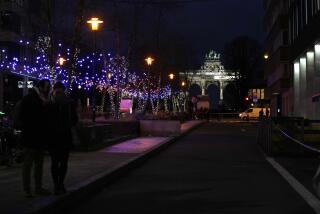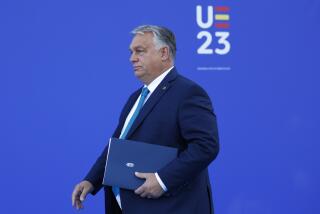The wall’s first crack
- Share via
Twenty years ago, on Sept. 11, 1989, the plug was pulled on the bathtub of Soviet empire.
At the stroke of midnight, tiny communist Hungary threw open the gates to freedom and the West. Tens of thousands of people surged across the suddenly unguarded border. Scenes of jubilation, of families reunited after decades of captivity in Eastern Europe, flashed around the world. Newsweek’s cover dubbed it the “Great Escape.” From one day to the next, Americans awoke to a startling new reality. Suddenly, it was possible to imagine the unimaginable: the fall of the Iron Curtain and an end to the Cold War.
The coming months will see a crescendo of 20th anniversary commemorations of communism’s final days, culminating on Nov. 9, the night the Berlin Wall came down. For many, Americans especially, the fall of the wall was a glorious moment, emblematic of the West’s victory in the Cold War. “We won!”
Yet if you watched the East Bloc’s disintegration from the ground, as I did over that fateful year, you saw it as more ambiguous. The founding fiction of our Cold War “triumph” -- that it validated decades of containment and militarist confrontation -- gives way to a more nuanced appreciation of the other forces that were at work. Among them: the actions of others, often unnoticed by the rest of the world. The Great Escape made history. But the real story, largely untold, is how it came to pass.
Every great event has its hidden turning points. Victory in World War II, some say, hinged on Operation Fortitude, Britain’s legendary gambit to fool Hitler into thinking the Allied invasion of 1944 would come near Calais rather than the beaches of Normandy. Similarly, the collapse of the Berlin Wall and the end of the Cold War had their roots, in part, in a bold gamble that unfolded, all but invisibly, one fine summer day in 1989 on the Austrian-Hungarian frontier.
The date was Aug. 19. The place: Sopron, a sleepy provincial town in western Hungary. Even in such a backwater, the winds of change were blowing. In Moscow, Mikhail Gorbachev was at work, shaking up the old Soviet sphere. In Poland, the famous trade union known as Solidarity faced off against its communist masters.
Closer to home, in Hungary itself, a new generation of reform-minded communists had taken charge. Almost overnight, they wrote a U.S.-style constitution and began speaking openly of a free press, free markets and free elections. Emboldened, a small group of local Sopron activists decided to celebrate the new spirit. Their modest aim: put up some tents, hire a brass band and let the beer and good vibes flow. One of the organizers came up with an especially inspired idea -- to briefly open a gate through the barbed-wire frontier to Austria, allowing people to casually stroll back and forth across the border for the first time in four decades. They called it the Pan-European Picnic.
Because anything involving the border was a matter of extreme sensitivity, their request for a permit came to the attention of Hungary’s young prime minister, Miklos Nemeth, the man behind so many of the Gorbachev-like changes taking place. Immediately, a light bulb went off in his head.
Every summer, tourists from East Germany descended on Hungary, where “goulash economics,” mixing Marxist industrial planning with a measure of free enterprise, provided things unavailable elsewhere in the grit-gray Soviet sphere: nice restaurants, ample food, good wine. But this year would be different. This year, Nemeth decided to use Hungary’s visitors as pawns in a great geopolitical chess game.
Since 1988, Hungarian citizens had been allowed to travel relatively freely. But East Germans were still not allowed by their government to cross into Western Europe. Although they could vacation in Hungary, there was a mutual treaty in force obliging the Hungarians to ensure that East Germans did not escape to the West.
Earlier in 1989, before the seasonal onslaught of East German tourists, Nemeth had very publicly ordered the electricity in the barbed-wire border with the West turned off. Border guards began ceremoniously cutting down large swathes of the barrier -- filmed by Western TV crews summoned for the occasion. Nemeth intended this as a clear message to Hungary’s East German guests. Look folks, he declared in effect, a hole in the Iron Curtain. There’s nothing to prevent you from “escaping” through it to freedom.
Nemeth hoped to unleash a flood. He believed that a mass escape of East Germans from Hungary would pose an existential threat to the regime of Erich Honecker, the dictatorial boss of the German Democratic Republic. He also believed that if Honecker fell, it would bring down the Berlin Wall -- and with it the entire communist bloc. Amid the chaos, he could realize his true goal. Hungary too would gain its freedom.
As plots go, this was ambitious, no less grand in scope and ultimate consequence than Winston Churchill’s Operation Fortitude. But there was a hitch. Hungary’s East Germans didn’t seem to be getting the message. Despite Nemeth’s televised border-snipping, only a handful had mustered up the courage to cross the border. And so he seized on the Pan-European Picnic.
Secretly, he and his team went into operation. As the day of the picnic approached, they put their own parallel plan into action -- in cahoots with the West German intelligence service. Fliers similar to those distributed by the official organizers soon began appearing in camps where East Germans were staying, emblazoned with the iconic image of a dove soaring in flight across the barbed-wire frontier. Come one, come all, they read. Eat, drink and be merry. Snip a piece of the Iron Curtain as a souvenir. But be careful not to stray. The border is unguarded. Why, you might just stumble into Austria and no one would notice!
Behind the scenes, buses were arranged to transport would-be escapees. Hungarian border guards were ordered to withdraw. As this new D-day dawned, the official organizers expected a few hundred people. Imagine their shock when the same scene played and replayed throughout the afternoon. Buses would arrive. East German tourists would get off, blink in confusion at the bizarre spectacle -- then dash toward the open border gate to Austria.
Fewer than 700 East Germans left that day, but it was enough. In the days after the Pan-European Picnic, what had been a fearful trickle quickly became a flood. As for Nemeth, he was proved a prophet. Within weeks, Honecker was ousted in a Politburo putsch. Within three months, the Berlin Wall fell. East Germany collapsed, revolution swept Eastern Europe and the Soviet empire was no more.
More to Read
Sign up for Essential California
The most important California stories and recommendations in your inbox every morning.
You may occasionally receive promotional content from the Los Angeles Times.










